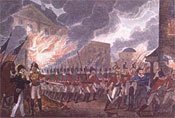 The Day the White House Burned
The Day the White House Burned
The Kings Troop Burn Down Washington DC
On June 12, 1812, the United States of America declared war on Great Britain. There had been a long period of simmering disputes between the nations, including Northwest Territory land disputes, the British impressment of American sailors, and British blockades of American commerce with France during the Napoleanic wars. It was the War of 1812.
In August of 1814, the British landed to the south of Washington, D.C., and marched inland. The only resistance the British Army encountered as they marched towards Washington was the brief Battle of Bladensburg in Maryland, a last ditch attempt to defend the city. Because the organized American Army was well to the north near Canada, only a hastily organized militia was available to defend the capital. For the British, this allowed a quick victory after which they were free to enter the city.
In retaliation for the torching of the Canadian capitol of York (now called Toronto), and to disgrace President Madison, they set fire to the president’s residence on August 24, 1814, burning down the White House.
The Burning of Washington is the name given to the burning of Washington, D.C., by British forces in 1814, during the War of 1812. The facilities of the U.S. government, including the White House, were largely destroyed, though strict discipline and the British commander’s orders to burn only public buildings are credited with preserving most residences. The attack was in retaliation for the U.S. invasion of York, Upper Canada (now Toronto, Ontario, Canada), at the Battle of York in 1813, in which U.S. forces looted and burned the city, including the Parliament Buildings of Upper Canada.
Only the exterior walls remained of the White House and those walls had to be torn down and mostly reconstructed due to weakening from the fire and subsequent exposure to the elements, except for portions of the south wall.
A legend emerged that during the rebuilding of the structure white paint was applied to mask the burn damage it had suffered, giving the building its namesake hue. This is unfounded as the building had been painted white since its construction in 1798. Of the many spoils taken from the White House when it was ransacked by British troops, only two have been recovered — a painting of George Washington, rescued by then-first lady Dolley Madison, and a jewelry box returned to President Franklin Delano Roosevelt in 1939 by a Canadian man who said his grandfather had taken it from Washington.
An urban legend in Montreal states that the original doors to the White House are located in the Blackwatch Building on Bleury Street. Some Canadian shipwreck treasure hunters have claimed that some of the spoils from Washington were lost when a convoy of British ships led by HMS Fantôme sank en route to Halifax off Prospect during a storm on the night of November 24, 1814. However Fantome did not take part in the Washington raid and most historians feel the convoy was only carrying goods and customs revenue from British-occupied Castine, Maine.
ATTENTION READERS
We See The World From All Sides and Want YOU To Be Fully InformedIn fact, intentional disinformation is a disgraceful scourge in media today. So to assuage any possible errant incorrect information posted herein, we strongly encourage you to seek corroboration from other non-VT sources before forming an educated opinion.
About VT - Policies & Disclosures - Comment Policy



